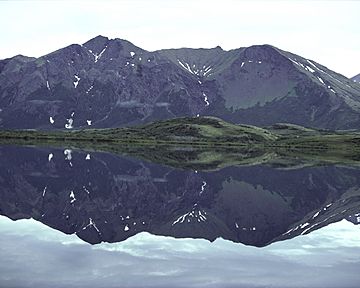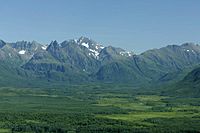Ahklun Mountains facts for kids
Quick facts for kids Ahklun Mountains |
|
|---|---|

View of the Ahklun Mountains reflected in a mirror-smooth glacial lake
|
|
| Highest point | |
| Elevation | 1204 |
| Dimensions | |
| Length | 80 mi (130 km) |
| Width | 30 mi (48 km) |
| Geography | |
| Country | United States |
| State | Alaska |
| Range coordinates | 59°23′0″N 160°42′0″W / 59.38333°N 160.70000°W |
| Parent range | Kuskokwim Mountains |
The Ahklun Mountains are a cool mountain range found in southwest Alaska. They are part of the Togiak National Wildlife Refuge. These mountains stretch from the Kanektok River and Narogurum River all the way to Hagemeister Strait and Kuskokwim Bay.
The Ahklun Mountains are special because they have the only glaciers in western Alaska. They are also the tallest mountains in Alaska west of the Alaska Range. Many peaks in this range have lots of glaciers. To the west of the mountains is the Kuskokwim River. To the east are the flat lands of Bristol Bay.
These mountains are home to many lakes. Some of these lakes are super deep, more than 1,300 feet (400 m) (1,300 feet) down! The Ahklun Mountains cover about 80 percent of the Togiak National Wildlife Refuge. The refuge also has wide, treeless plains called tundra and flat areas near the coast.
Contents
Environment in the Ahklun Mountains
The Ahklun Mountains are mostly covered by alpine tundra. This is a cold, treeless area found at high elevations. You can also find low-growing plants like heath and rocky, barren spots. In the valley bottoms, there are moist meadows with sedge and tussock grasses.
Some hills and ridges have black spruce forests. Along the big rivers, you'll see forests of white spruce, paper birch, and alder trees. Birds like the Blackpoll warbler often nest in the conifer trees found in these river valleys.
Wildlife in the Mountains
Beavers are very common here. People even harvest them each year. The most common fish is the Sockeye salmon. Other fish like chum, king, silver salmon, and rainbow trout are also found in large numbers.
The weather in the Ahklun Mountains is quite cold. The average yearly rainfall is about 19 to 25 inches (480 to 640 mm) (48 to 64 cm). The average temperature for the year is between 29 to 33 °F (−2 to 1 °C) (minus 1.7 to 0.6 degrees Celsius). Plants usually grow from about May 15 to September 10.
Glaciers in the Ahklun Mountains
The United States Geological Survey (USGS) first mapped the glaciers here. They used special aerial photos from 1972 to find 116 glaciers. In 2006, they checked again. They found 97 glaciers were still there, but 12 seemed to have vanished. This showed a big drop in the amount of land covered by ice in just 30 years. Scientists know that glaciers are important clues about how the Earth's climate is changing.
In 2015, researchers looked at more aerial and satellite images from 1957, 1984, and 2009. They discovered that 10 of the 109 glaciers mapped by the USGS in the 1970s had completely disappeared. They also compared the size of the glaciers. They found that the glaciers had shrunk by about half of their total area. If they keep melting at this speed, scientists believe all the glaciers in the Ahklun Mountains could be gone by the end of this century.
Geological studies show that during the Pleistocene Ice Age, glaciers repeatedly covered this area. These glaciers carved out many deep valley troughs. On the eastern side, these troughs now hold many glacial lakes. Some of these lakes are over 1,300 feet (400 m) (1,300 feet) deep. They are held back by piles of rock and dirt left by the glaciers, called terminal moraines. On the southern and western sides, the valleys are wider. They have rolling upland areas with rugged, rocky massifs sticking out.
Lowlands of the Ahklun Mountains
In the lower areas, which were not covered by glaciers, you can see different features. The main features are moraines and ridges. These were formed by the powerful pushing of ancient ice sheets.


